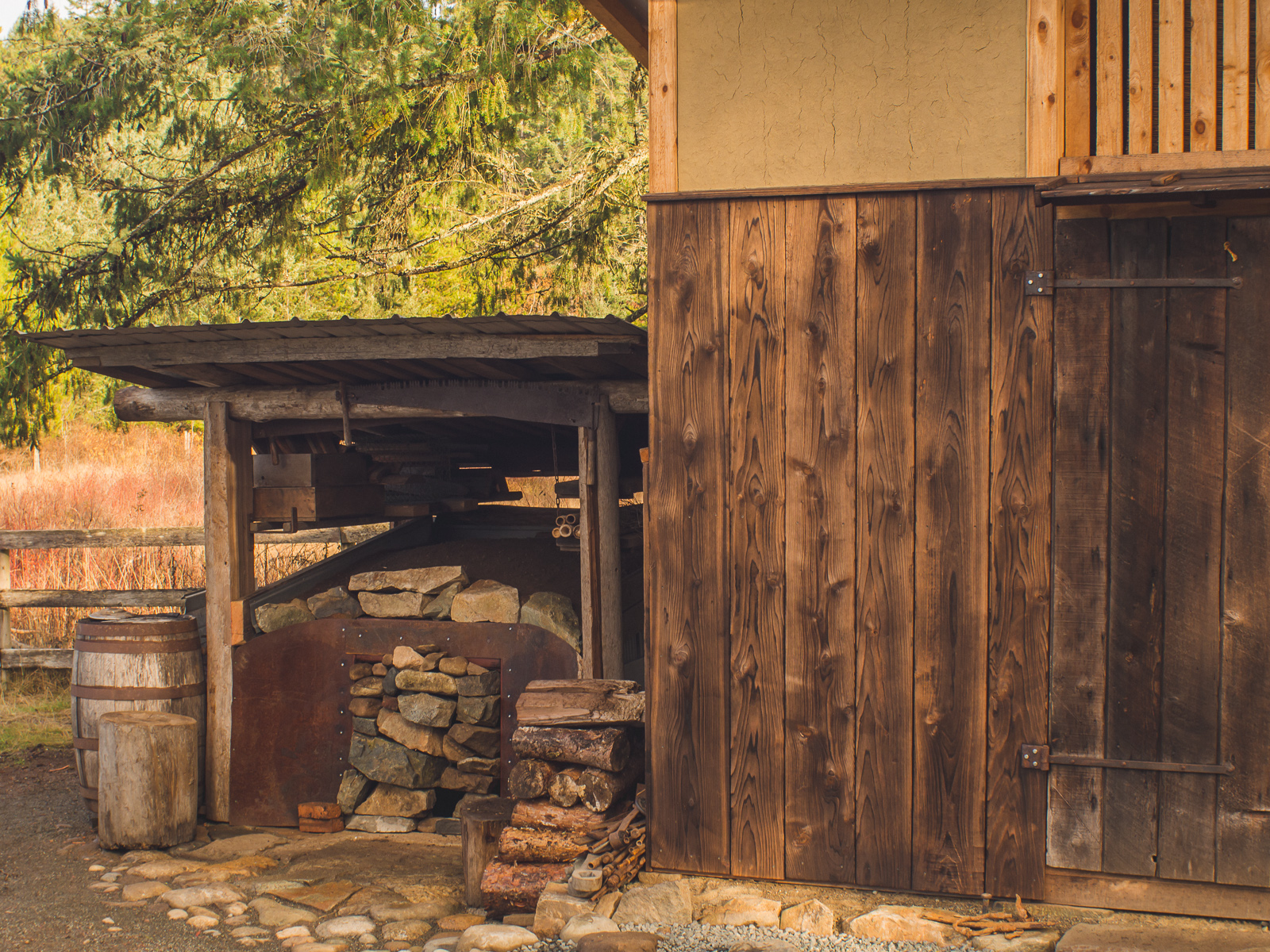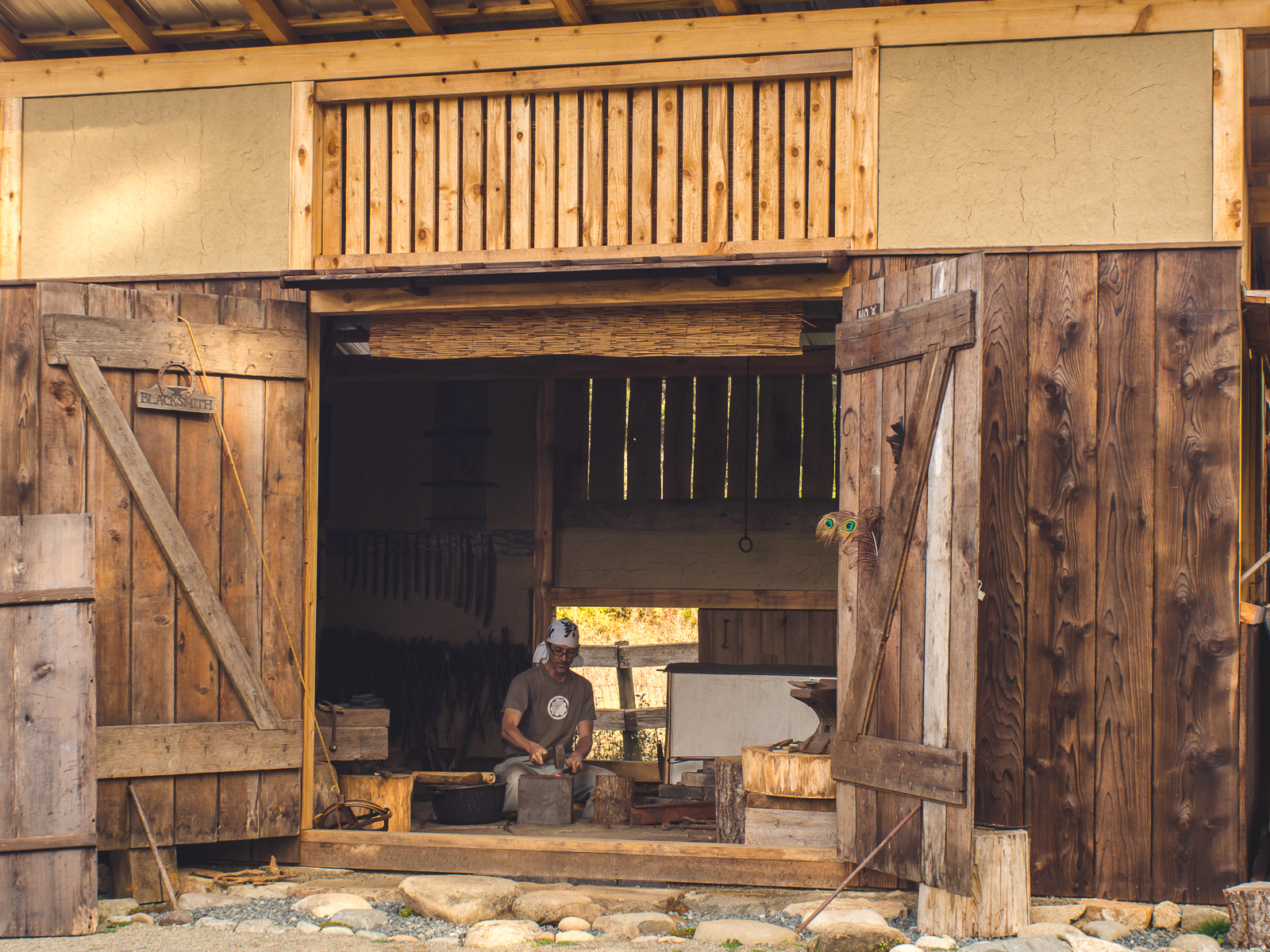A Tour of the Workshop
Walk through the shop and see where it all happens from charcoal making to finishing a blade. The workshop set up is fairly simple and requires but a few basic tools. All of the tools here are either antique, handmade, or both. Many blacksmith tools can be made by the smith, including the forge, specialized tongs, hammers, and chisels. See the construction of the workshop.
Charcoal Kiln
The fuel for the forge is made from construction scrap and deadfall pine wood in an outdoor kiln.
More about making charcoal: How Charcoal is Made




Forge
The bladesmithing style forge is a relatively simple version of a sideblast charcoal forge. Two rows of bricks contain the charcoal but allow for long pieces to be heated in the centre. Air from the fuigo box bellows comes in the left side near the bottom. In addition to heating the steel to shape blades, the forge can be used to anneal, silver solder, and patinate copper.
More about forging blades: Forging a Tanto Blade

Fuigo Box Bellows
The bellows provide the air to the forge to increase the temperature of the fire. Japanese style box bellows are constructed almost entirely of wood and supply a highly controlled air blast to the forge on both the push and the pull stroke.
More about the benefits of a Japanese swordsmith’s style fuigo box bellows: Why *You* Need A Swordsmith’s Fuigo Box Bellows

Anvil
The anvil is the table which supports the steel as it is hammered into shape. Bladesmithing anvils need not be more than a rectangular block of steel, this one is 255lbs, about half of it set into the floor. The eighty year old John Brooks London-pattern anvil is useful for other forging work such as making fittings and tools. Portable or part time anvils are good in the 100-130 pound range, a shop anvil for regular work is better in the 150-250 pound range, depending on the work. For Japanese sword style bladesmithing, a thin layer of water is used on the anvil to keep the fire scale off of the blade as it is forged.


Charcoal Bin
Finished charcoal is chopped and stored in a metal bin for use in the forge. The steel bin helps keep the charcoal dry, and prevents sparks from igniting the large stored supply before its time. The shovel was made from farm machinery almost a century ago by a prairie blacksmith.
Watch a video about making charcoal: How Charcoal is Made or see how charcoal is chopped and sorted for swordsmithing.


Tongs
Blacksmiths must have a variety of long-handled tongs for holding hot steel as it is shaped. Tongs must hold steel tightly to avoid slipping or dropping under the forces of hammering. This set has been modified from a more standard type and is designed specifically to hold the tapered tangs of tanto during the later stages of forging.

Hammer
Bladesmiths often use two or three different hammers during the process of forging a blade. Initially, a heavy hammer reduces the stock to approximate dimensions and then a lighter hammer takes care of the controlled shaping and finishing through the sunobe stage and beyond.
Hammers may be made by the smith for specific weight and shape preferences. A recommended weight range for the large hand hammer is 1.4kg-2kg (~3lbs-4.5lbs) and the smaller one is 0.9kg-1.4kg (~2lbs-3lbs). The large mukozuchi for a striker is usually between 3貫/kan (11.25kg / 24.8lb) and 1貫/kan (3.75kg / 8.26lb).
Read more about these hammers and find out why *You* Need A Japanese Swordsmith’s Hammer.


Bamboo Water Scoop and Straw Teboki Brush
Forging with a thin film of water on the anvil and hammer prevents forge scale or oxide from being hammered into the surface of the steel. The hot steel instantly vaporizes the water and the resulting steam explosion blows the scale off of the work, keeping it clean as it is worked. This type of bamboo scoop is a traditional style tool for applying water to the surface of the anvil or the hot steel.
The straw teboki (手箒, hand broom) serves a similar purpose of cleaning scale off the anvil and applying a thin layer of water, and is also used to shield the smith from flying sparks and scale when a striker is using the large hammer.


Aku & Dorojiru
Two traditional flux materials are used in combination for tanren and forge welding processes. They prevent carbon loss and protect the steel from oxidization which causes the weld to fail.
Aku (灰汁) is charcoal made by controlled burning and then smothering of straw (specifically rice straw if available). The resulting fine flaky mixture is used as a flux and as protection from carbon loss during tanren and forge welding operations. A tray is usually placed between the forge and anvil during tanren so the billet can be rolled in aku on the way to the anvil then rolled again and coated with clay slurry on the way back to the fire.
Dorojiru (泥汁 doro/dorojiru) is a thin slurry mixture of natural clay and water used as a flux during certain stages of tanren and forge welding. The mixture is spooned over the billet after it has been rolled in aku and quickly dries to form a coating on the way back to the forge.


Leg Vise
A blacksmithing standby, the leg and thick forged jaws can handle most anything from filing to hammering. The vise holds the blade while it is being profiled with a file. In addition to very sturdy construction, a post vise has an iron leg that goes straight to the floor under the rear jaw. This transfers the energy of hammer blows to the floor instead of breaking out the bolts mounting it to the bench. The long handle provides plenty of leverage for tightening, and the smooth jaws do not mar the soft, hot iron.
A vise should be mounted at the height of a ‘smith’s elbow for operations such as filing and bending. This tool was forged around a century ago and is on its last, and only, leg. Until recently it remained mounted to the original wooden stand I had used for it since 1992.
See it in the process of making a blade: Shaping a Tanto Blade (Ara-Shiage)


Sen Dai
The staple vise solves the dual problems of getting clear access to the sides of a blade, and of steel jaws marring the soft steel of the tang. Various wooden wedges are used to hold a blade securely for scraping and filing.
See it in action: Shaping a Tanto Blade (Ara-Shiage)


Quench Tank
Hot water provides a proper cooling rate for clay coated steel to become hard without cracking. The water is heated with waste heat from the forge prior to yaki-ire. This tank is aluminum, but will have a limited lifespan due to the alkalinity of the water from bits of floating charcoal ash in the shop.
More about the process of hardening a blade: Yaki-ire (clay tempering)

Kaji-Togi Dai (Rough Polishing Bench)
After quenching coarse stones are used to remove excess steel and move the blade closer to its final geometry before making fittings and other parts. The coarse stones sit on a wooden support consisting of a board with a hook over the edge of a stump or anvil. Coarse stones may be used dry and the powder is saved for use in the yaki-ire clay mixture. Finer stones are used in several stages to shape and refine the blade.
See the process of polishing a blade: Polishing (togi)

Post Drill
The post drill is used to create the mekugi-ana in the tang of the blade. Turned by hand, progress can be carefully watched and adjusted as necessary. This machine was made in Canada around the turn of the century and still has some miles left to go. Cast into the frame are the model number, 614 (from 1914), and the words, “Can. Blower & Forge Co. Ltd. Kitchener, Ont”.
More about the post drill: Post Drill Repaired

Sun Tiger Hand Grinder
A hand powered grinding wheel is used to sharpen, repair, and maintain hard tools like sen scrapers and broken chisels. Slow speeds keep the risk of overheating the steel to a minimum.

Shiage-Ba (Finishing Shed)
Forging, shaping, and kaji-togi polishing can be done in the kajiba, but finishing work must be done in a cleaner area. This small shiageba provides work areas for carving saya (scabbards) and tsuka (handles), polishing blades, and other finishing work such as lacquering with natural urushi and tsukamaki (handle wrapping).

Woodworking Area
The loft area of the shiageba provides a small two mat floor woodworking space for carving saya (scabbards) and tsuka (handles) along with storage for tools and seasoned wood. The window faces north to provide stable lighting conditions throughout the day.



Togi Dai (Hand Polishing Platform)
A togi-dai (研ぎ台) polishing platform is a traditional workspace used to orient the stones at a proper angle to the polisher and to collect and manage the water and swarf that comes from the process. The polishing components include a sloped wooden platform to drain and collect water, a water bucket and stone rest, a foot clamp to hold the stone down, and a slanted stool for the polisher. After all of the components of a knife are finished, increasingly finer waterstones are used as the blade becomes smoother and the geometry more refined.
See the process of polishing a blade: Polishing (togi)



See a photographic history of the blacksmith shops and creative spaces I have worked in since 1990: Workshop History



